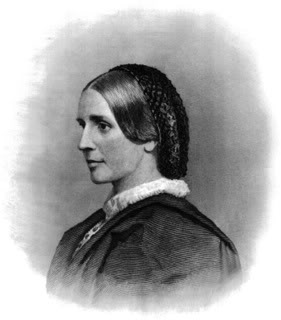Emily Parsons was born on March 8, 1824 in Taunton, Massachusetts, the daughter of Professor Theophilus Parsons of the Harvard Law School and granddaughter of the late Chief Justice Parsons of Massachusetts. She was educated in Boston.
She was 37 years old and living in Cambridge at the beginning of the Civil War.
 |
| Fort Schuyler |
 |
| Fort Schuyler Hospital |
After eighteen months of training, she was placed in charge of a ward attending fifty wounded soldiers at Fort Schuyler Military Hospital on Long Island in October 1862. For two months, she performed the duties of hospital nurse, but her health deteriorated further.
After a rest, Parsons wrote to Dorothea Dix, superintendent of Union nurses, offering her services wherever they might be needed. At the same time, she became friends with Jessie Benton Fremont, who recommended Parsons to the Western Sanitary Commission at St. Louis, and she was immediately telegraphed to come at once to St. Louis. Every available building in St. Louis was converted into a hospital, and the sick and wounded were brought from Vicksburg, Arkansas Post and Helena up the river to be cared for at St. Louis and other military posts. At Memphis and Mound City (near Cairo), at Quincy, Illinois, and the cities on the Ohio River, the hospitals were in an equally crowded condition.
 |
| The City of Alton Steamboat |
The monotonous army diet of hard bread, salted meat, and coffee without milk needed to be supplemented with fruits, vegetables and dairy products; and inexperienced soldiers needed to learn about proper drainage in the camps and how to set up tents for maximum ventilation. Parsons and others took it upon themselves to give proper attention to the dietary needs and hygiene of the soldiers.
By the time she recovered, the war was over, and she devoted herself at home to working for the freedmen and refugees. She collected clothing and garden seeds for them, many boxes of which she shipped to the Western Sanitary Commission at St. Louis to be distributed in the Mississippi Valley, where they were greatly needed.
In the spring of 1865, she took a great interest in the Sanitary Fair held at Chicago, collected many valuable gifts for it, and was sent for by the Committee of Arrangements to go out as one of the managers of the department furnished by the New Jerusalem Church – the different churches having separate departments in the Fair.
Emily Elizabeth Parsons died of a stroke on May 19, 1880.
 |
| Parsons Building, Mount Auburn Hospital |
Efforts to raise funds for a hospital continued in her memory. In 1883, Dr. Morrill Wyman purchased a nine-acre plot on the Charles River near Gerry's Landing, and the building of Mount Auburn Hospital began. The first hospital structure was completed in 1886, and named the Parsons Building in Emily's honor.
After her death, her father published her correspondence detailing her experiences as a war nurse, Memoir of Emily Elizabeth Parsons.
After her death, her father published her correspondence detailing her experiences as a war nurse, Memoir of Emily Elizabeth Parsons.


No comments:
Post a Comment